Cruising Stories are little snippets of the cruising life, telling about the ups and downs, triumphs and challenges of this life. In this episode, Michele Watson tells of the challenges of cruising with lymphedema and her personal triumph, with a heavy emphasis on “you can do anything you set your sights on.”
Thanks to Michele for telling her story. Many of the photos here she hasn’t shared publicly before, and I appreciate her willingness to do so here.
 My husband, Al, and I had a dream that we would retire and go cruising “someday.” Al was raised on the coast of Connecticut and has always been on the water, either power or sail. We remodeled and sailed four sailboats together and finally realized our cruising dream on the fourth boat, a 1987 Morgan 43 Center Cockpit. We carefully remodeled Kindred Spirit for living aboard and sailing south. Our intention was to do extended cruising south to the Bahamas for 8 months but maintain our small home in Connecticut and spend summers there.
My husband, Al, and I had a dream that we would retire and go cruising “someday.” Al was raised on the coast of Connecticut and has always been on the water, either power or sail. We remodeled and sailed four sailboats together and finally realized our cruising dream on the fourth boat, a 1987 Morgan 43 Center Cockpit. We carefully remodeled Kindred Spirit for living aboard and sailing south. Our intention was to do extended cruising south to the Bahamas for 8 months but maintain our small home in Connecticut and spend summers there.
In 2011, before we retired, I was diagnosed with ovarian cancer, fortunately at an early stage. Following my surgery and six months of chemotherapy, I worked another 18 months and then retired so that we could go cruising. The decision to go cruising was complicated by my new disease, lymphedema, a consequence of the cancer surgery. The removal of lymph nodes throughout my abdomen led to the development of lymphedema (LE) in my right leg. Lymphedema is an abnormal buildup of lymph fluid in the tissues under the skin when the body’s lymphatic system is unable to transmit the fluid. The standard removal of lymph nodes during cancer surgeries puts the patient at risk for developing this incurable and progressive disease. The incidence among gynecological cancer survivors is between 20-40%, and between 6%-25% for breast cancer survivors.
I had never heard of lymphedema before my own diagnosis and this possibility was never discussed with me during my cancer treatment. Lymphedema, both primary and secondary, has been an invisible disease among the medical profession as well as the general public. And yet, LE affects 10 million Americans, more than AIDS, Parkinson’s Disease, Muscular Dystrophy, Multiple Sclerosis and ALS — combined.

WHAT IS LYMPHEDEMA?
The lymphatic system transports lymph fluid, a mostly clear fluid consisting of white blood cells that help fight infection, water, waste products, fats and proteins. This fluid is drained from tissues and circulated throughout the body through lymph vessels and is filtered though the lymph nodes.
Lymphedema (LE) is the result of trauma to the lymphatic system or an abnormal development of the lymphatic system. The symptoms can vary from individual to individual but include swelling of the affected limb(s), thickening of the skin, feeling of heaviness and tightness to the skin, fatigue, discomfort and sometimes pain. I will never forget the first time I googled photos of lower limb lymphedema – the advanced cases were frightening and disturbing to see. I vowed to never let my lymphedema reach that stage.
Lymphedema is incurable and can only be managed by 24/7 vigilance and knowledge. The “gold standard” of treatment for LE consists of:
-

The height of fashion with my wrapped right leg Intensive treatment phase: Complete Decongestive Therapy (CDT) by a certified lymphedema specialist:
- Daily sessions for a period for 2-3 weeks (or however long it takes depending on severity)
- Each session includes “manual lymph drainage” (MLD), a specialized massage technique to move the lymph fluid out of the affected area.
- Compression wrapping with layers of foam and bandages that remain for 24 hours, until the next day’s appointment.
- Self-care maintenance phase:
- Wearing compression garments daily, and usually every night
- Regular exercise while wearing compression garments
- Meticulous skin care
WHAT DID THIS MEAN FOR OUR CRUISING PLANS?
No one told me I could not go cruising, but I also don’t think there were many other folks out there trying it. To this day, I have not met another person with LE who lives aboard, cruises extensively or even cruises for a few weeks each summer. In the summer of 2013, I had been dealing with the lymphedema for only 18 months and knew a lot less about the disease then. After surviving cancer, I didn’t want anything else to hold us back from realizing our dream, even if that dream would require some adaptations and modifications.
I began a blog Kindred Spirit as a journal for our trip and have maintained it for the past 5 years, mostly for our cruising adventures, 2013-2014 and 2015-2016. Of the 230 blog posts to date, only 8 mention my lymphedema. Photos are usually cropped to conceal my leg. Although I was generally open and honest about the lymphedema, I was also self-conscious.

There are no medications or pills for LE. Each person’s LE can vary – what triggers it, how much swelling is “normal” and when serious attention is needed. You need to know your own lymphedema. Although there is no scientifically proven lymphedema diet, it is important to eat a balanced and healthy diet. Excessive weight will add greater demands on the lymphatic system and make things worse.
I did not have CDT before we departed on Kindred Spirit for the first time in 2013, only MLD twice a week, for 4-6 weeks, periodically throughout each year. I wish I had had the proper treatment earlier in my LE journey, but that’s another story. Finding a certified lymphedema therapist can be a challenge anywhere, but it could be quite difficult when cruising, especially considering the time commitment for CDT. I was able to cruise for 8 months without treatment, but I now only go 6 months without a tune-up.
MANAGING LYMPHEDEMA – COMMITMENT AND DILIGENCE, ON LAND OR AT SEA
The most important thing I did, faithfully, every day, was to wear my compression garments. The “over-the counter” less expensive options do not fit me well so I wear custom-made, heavy-duty compression stockings, usually full pantyhose without toes or a capri-style down to my foot. My private insurance covered 8 pairs per year, but Medicare does not cover any, even with supplemental insurance. The cost for each pair ranges from $500 to $1100, depending on the type of fabric, thigh high for one leg or full pantyhose.

The compression garments aren’t all that comfortable, but I did get used to them, except in the heat. While everyone else beats the heat with shorts and bare legs, I usually wore a skort or active skirt/dress with my compression. Sometimes my black compression garments can even look stylish.
When worn daily, a compression garment should last 4- 6 months. Needless to say, at these prices one takes very good care of them! Proper care includes daily washing and hanging to dry. That is quite a challenge while cruising. Laundry day was usually every 2-3 weeks and it just isn’t possible to have 15-20 pairs of compression stockings! Handwashing was an option but doesn’t clean them as well. To be honest, I didn’t wash my compression garments every day while cruising. I would literally hold my breath each time I used a laundromat hoping that the washer would not destroy my precious garments.

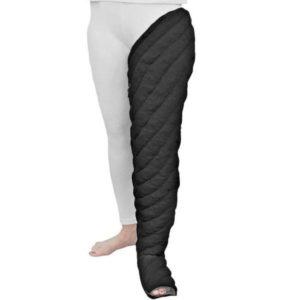 The daytime compression cannot be worn at night. Some folks with LE do not need a night garment, but I find a special night garment to be an effective addition for controlling my LE. The specialized compression with quilted channels helps to move the lymphatic fluid. Admittedly, it is not very sexy and it is rather warm in the heat. Needless to say, I do not have a photo of myself wearing one. 😉
The daytime compression cannot be worn at night. Some folks with LE do not need a night garment, but I find a special night garment to be an effective addition for controlling my LE. The specialized compression with quilted channels helps to move the lymphatic fluid. Admittedly, it is not very sexy and it is rather warm in the heat. Needless to say, I do not have a photo of myself wearing one. 😉
Skincare is a critical component of LE care. The first rule is to protect your skin from sunburn, which everyone should do! Insect bites, cuts and scrapes while cruising can have more serious consequences because of the compromised lymphatics. Cellulitis, when bacteria infect the deep layers of skin and tissue beneath the skin, can be extremely serious, requiring an immediate trip to the emergency room or hospital for antibiotics. Fortunately, I have never suffered from cellulitis. I immediately cleaned any cut, scrape, or insect bite and covered it in an antibiotic ointment. Much to my surprise, mosquitos DO bite through compression stockings!

Exercise is just as important for lymphies as anyone else, perhaps even more so. Exercise makes the muscles contract and pushes lymph through the lymph vessels, but compression garments must be worn. At home, I would walk two miles 4-6 times per week, but that wasn’t always convenient or possible traveling back and forth on the Intracoastal Waterway (ICW). I have a pneumatic compression pump system that mechanically moves lymph fluid. It is not a replacement for Complete Decongestive Therapy or Manual Lymph Drainage, but it was better than nothing. Five to six times each week I would spend an hour in the “machine” as we fondly called it. The Flexi-Touch was in our second cabin and out of the way. I really didn’t mind that hour each day because it gave me a little“quiet time” for reading or a nap. I just wish I had taken a photo of me using it!
Physical activity is more challenging than before I developed lymphedema. I tire more easily, my leg is less flexible, and my balance is sometimes off. I could usually plan on one big activity a day, with perhaps a rest day in between. Long walks to a grocery store or touring an interesting port that require hours of walking was sometimes exhausting, resulting in more aches and heaviness in my leg. Biking was a great alternative for exercise, touring a new port, or fetching groceries.

I missed the spontaneity of walks on the beach and jumping into the waves. If I wore the footless compression, I could feel the sand between my toes and walk on the beautiful white beaches in the Bahamas. That counts for a lot. Full disclosure – While in the Bahamas and here at home during New England summers, I do take 2-3 hours off from my compression and spend time sitting on the beach. A girl has to live, right?
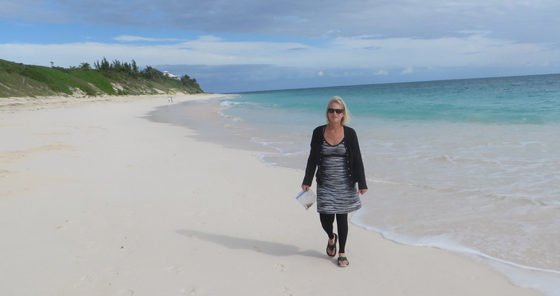

Once we were in the Bahamas, snorkeling and exercising in the water was my preferred activity. No compression garments are needed because the water provides a good level of pressure on its own. The water is a place where I can truly feel “free.” Oh, to be a mermaid!


After our first adventure to the Bahamas, we sold our beloved sailboat, Kindred Spirit, and purchased a 2003 Mariner Orient 38 trawler. She is our third Kindred Spirit. Although we loved sailing, the trawler is more comfortable for me and my lymphedema. After 12 months of transforming the trawler, we made our second voyage to the Bahamas in 2015-2016.
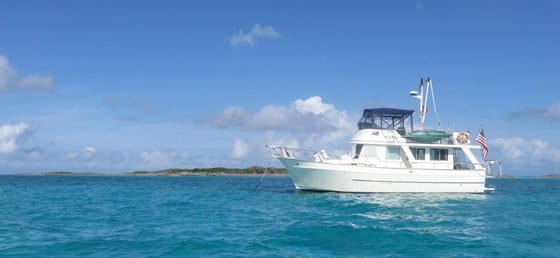
Without a doubt, lymphedema made cruising more challenging, but I have no regrets about our two trips to the Bahamas and back. It took a little more determination and a patient husband, but I did it. I did it.

Information and Resources for Lymphedema
Lymphatic Education and Research Network https://lymphaticnetwork.org
The National Lymphedema Network https://www.lymphnet.org
10 Things LE http://10thingsle.info
Lymphie Strong https://staylymphiestrong.com

Carolyn Shearlock has lived aboard full-time for 17 years, splitting her time between a Tayana 37 monohull and a Gemini 105 catamaran. She’s cruised over 14,000 miles, from Pacific Mexico and Central America to Florida and the Bahamas, gaining firsthand experience with the joys and challenges of life on the water.
Through The Boat Galley, Carolyn has helped thousands of people explore, prepare for, and enjoy life afloat. She shares her expertise as an instructor at Cruisers University, in leading boating publications, and through her bestselling book, The Boat Galley Cookbook. She is passionate about helping others embark on their liveaboard journey—making life on the water simpler, safer, and more enjoyable.
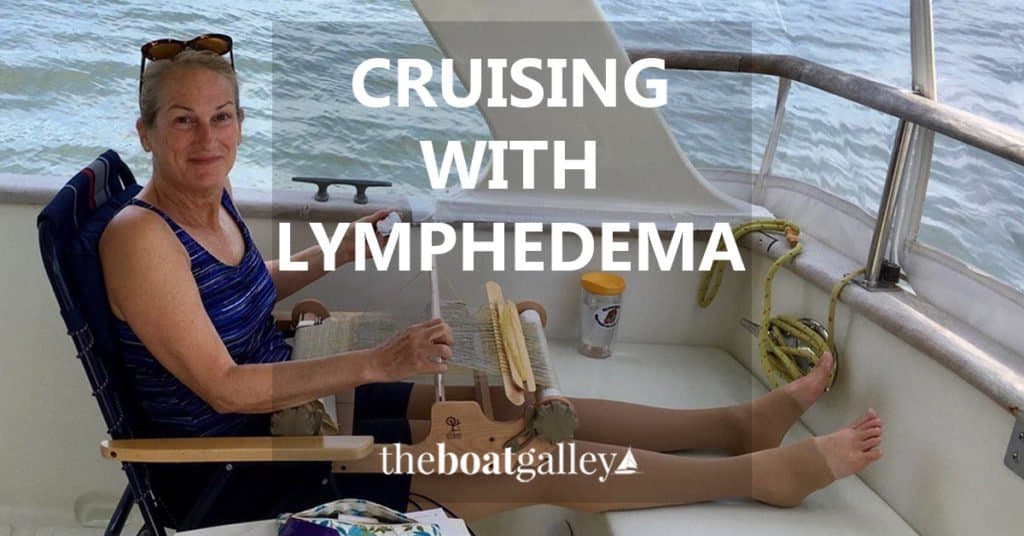

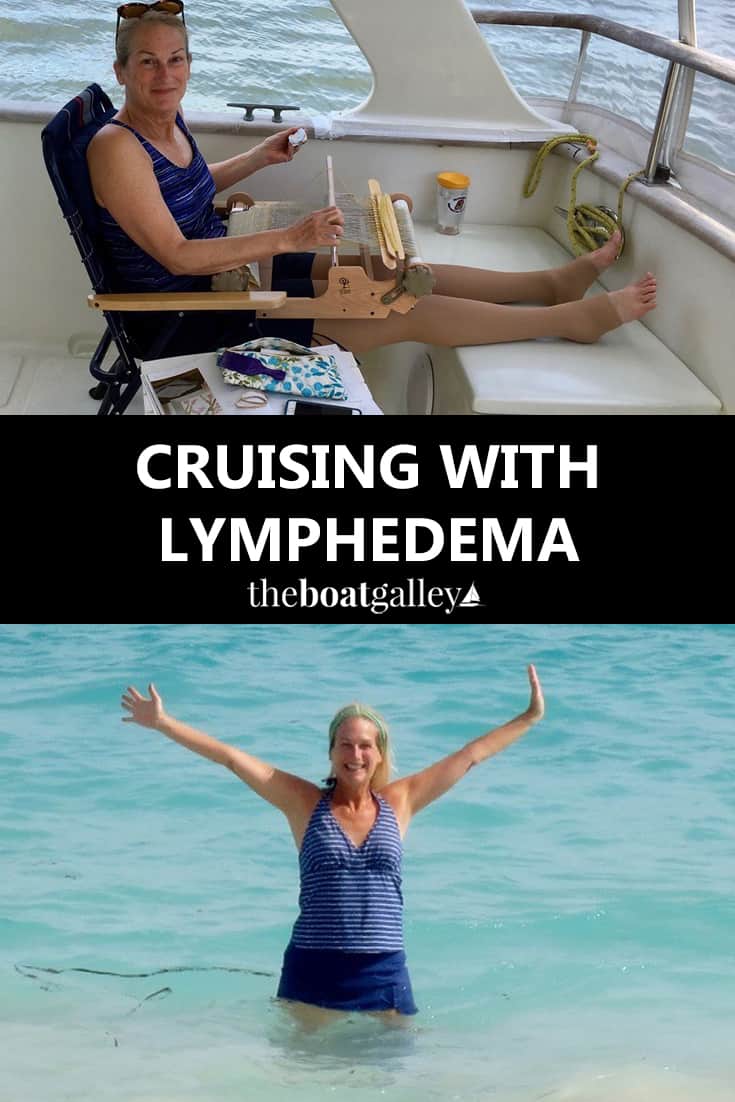
Carol Freeland says
Thank you for sharing your story! I appreciate the great suggestions for adapting an active lifestyle to your needs.
Cathy Wehle says
I was excited to read your story. My son suffers from Lymphedema and has for 15 years. He is only 39. He just had a set back but has finally found a Licensed Therapist to help him on the road to recovery. I will share your story with him so he can see how anything is possible. Love reading your adventures. We too have gone from a sailboat to a GB trawler…We are in the Pacific Northwest…so more clothes.
Thanks for sharing
Michele Watson says
Finding a good qualified CLT is the most important thing your son can do to manage and learn to live with, and beyond, his LE. I wish him well!
Michele
Clive says
Wonderfully written article, Michele! I am sure that you will help many people out there realize that they can do it too!
Clive
Jackie Tetreault says
Michelle. You are an amazing person and an inspiration to many. God bless you for your strength and determination.
Lesley Keeble says
Hi Michelle !
I had late stage Ovarian 3.5 years ago and am in remission . After the removal of 33 lymph nodes that proved to be thankfully negative I developed Lymphadema . My labia, pelvic region, abdomen and entire left leg are involved . I have all the equipment that you have . You are the first person I have met in 3.5 years with the same affected body parts and equipment .
I swim 5x weekly and that helps . Lately my leg seems be getting worse and I’m puzzled because it is winter and the weather has cooled off . My Lymphadema therapist left town and I’m thinking I need to consult another therapist on my leg .
So nice to meet you !
Michele Watson says
Hello Leslie,
I would definitely seek a new CLT and have a consultation. My leg fluctuates too and I need a “tune-up” every 4-6 months. Good Luck with your search!
Michele
Kathy Wood says
Hi Everyone,
I have leg and abdominal lymphodemia for 3 years plus.,uterine cancer. It can be fixed,!!!as my micro surgeon Dr .Patel of USC fixes 100 legs a year for the past three years. He does all areas of the body, I only know his statistics for legs. It is a plumbing problem, plain and simple. 6weeks ago I had an out patient LVA procedure done and my leg where the procedure was done is practically normal. Mind you it has only been 6 weeks. My physical Therapist yesterday said I can feel your bone for the first time, in 3 years. Your legs feels like a normal leg should feel.
I am walking evenly, now.Japan has been doing these procedures for 20 years. England does them as private pay in Oxford. It is criminal that the American Medical community does not educate our oncologists etc. Kathy Wood
Michele Watson says
Hi Kathy!
How wonderful to hear that your LVA (Lymphaticovenous anastomosis) surgery was successful. Although there is still no cure for lymphedema, there certainly has been progress in surgical approaches such as LVA, LNT (lymph node transplant) and suction-assisted protein lipectomy (a specialized form of liposuction.) Lymphedema varies greatly from person to person and not every LE patient is a candidate for a surgical approach. Anyone considering surgery should research it very carefully and know the characteristics and specifics of their own case. The Lymphatic Education & Research Network (https://lymphaticnetwork.org) is one of the best online sources for reputable information. There are online video symposiums from experts in the field of lymphatics. LE&RN has also hosted a two-day conference in Boston for the past two years including one day just for lymphedema patients. It was a wonderful opportunity to learn from the experts in the field of lymphatics, including traditional and surgical treatments. I am in the process of exploring whether or not any surgical option would be appropriate for me,
Good Luck! I hope that your leg continues to improve – it must feel wonderful!
Michele
Allison says
Thank you so much for sharing your inspiring story.
Might I also please add additional resources for finding certified lymphedema therapists – no matter where life’s travels take you.
There is an App developed by the American Lymphedema Framework Project called Look4LE that helps locate 135-hour trained therapists (see http://www.alfp.org for instructions on how to download the app and for additional educational resources. .
Certified therapists can also be located using the tools at http://www.clt-LANA.org
Thanks again for your meaningful post!
Michele Watson says
Great information, Allison! Thank you for adding that.
Brenda says
Thank you for being open and sharing your story & great resources. You are an incredible woman! After breast cancer, I suffer from lymphedema in my left arm. Like your experience, nothing was told to me about LE in advance, or while undergoing 3 surgeries, 7 months of chemo or 2 months of radiation, all of which affected my lymph system. Fortunately, after initial physical therapy, compression garments and daily self-massage, my case is not too bad to deal with.
Thanks to Carolyn for using her forum to air a story that initially seems like something that affects only a narrow group of people, but actually there are many of us.
Janine says
I am in awe! I suffer from chronic disease also but you have truly inspired me! Thank you for sharing and for your strength.
Jeff says
Hi Carolyn. Thank you for this wonderful website. It made my day!
I’m wondering if you have much experience flying and especially on any long haul flight. I just went on a five-hour flight and my leg edema seems to have spread north of my knee all of a sudden. I was wearing my custom socks and did my exercises. Maybe this is a coincidence? But if not, it will be life-changing. Thank you for this wonderful website. It made my day!
Carolyn Shearlock says
This post was written as a guest post by a reader of mine. I’ve passed your question on to her to see if she has an answer. I do know what the lower pressure in airplane cabins can cause problems with other swelling (a broken arm once swelled hugely on a flight and stayed that way for nearly a week), so it may be a side effect. Certainly hope it goes away with time.